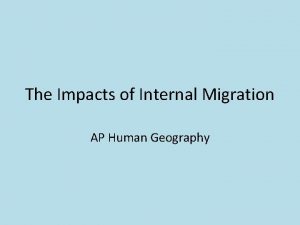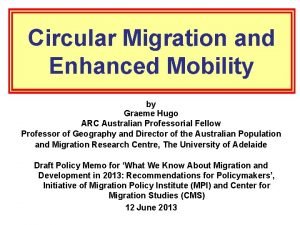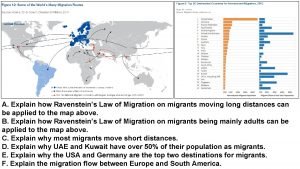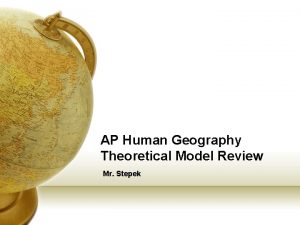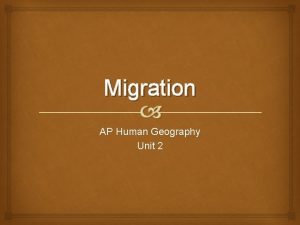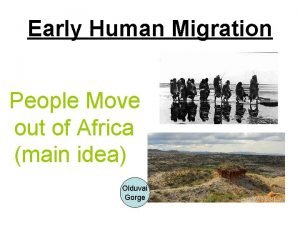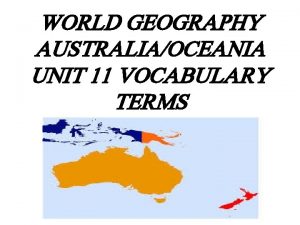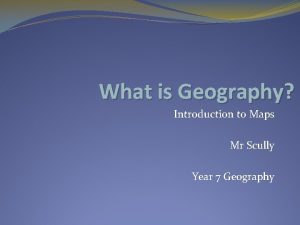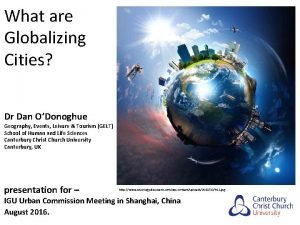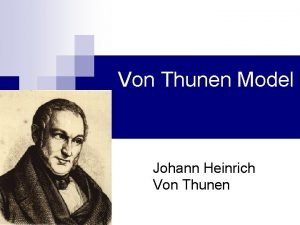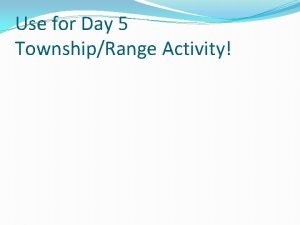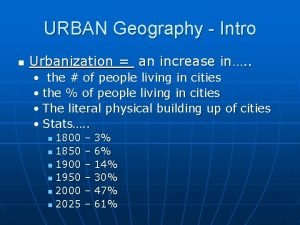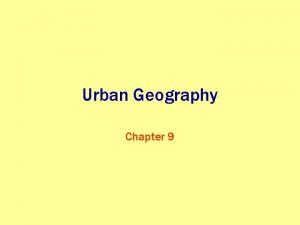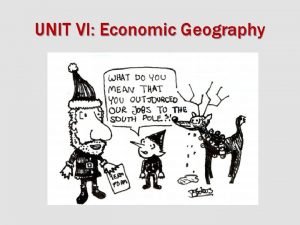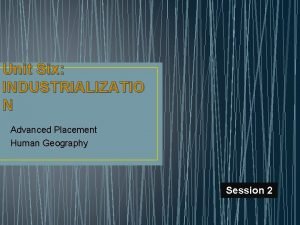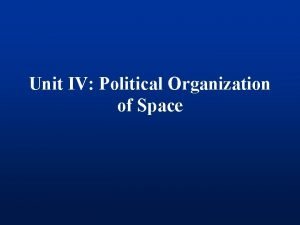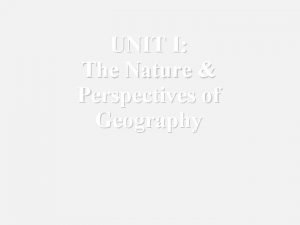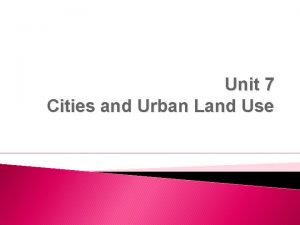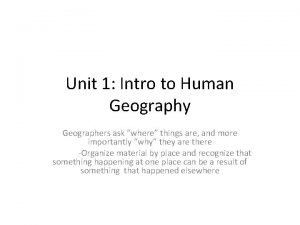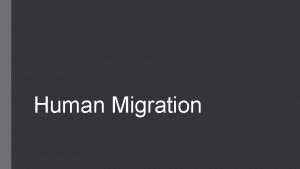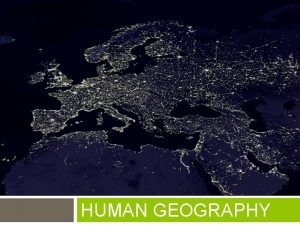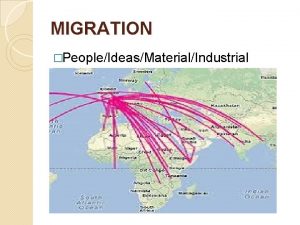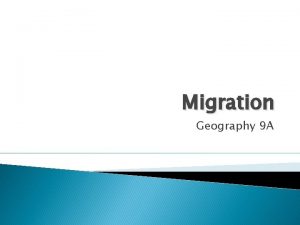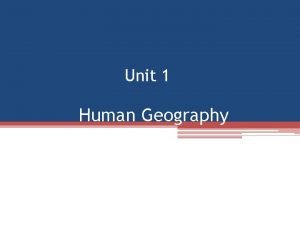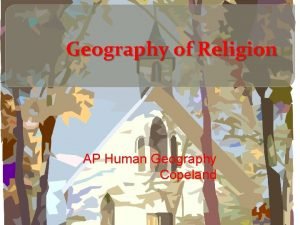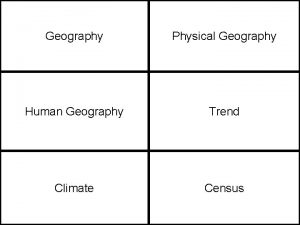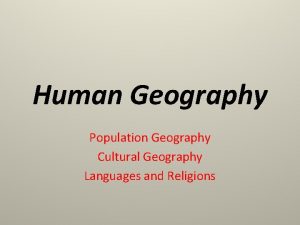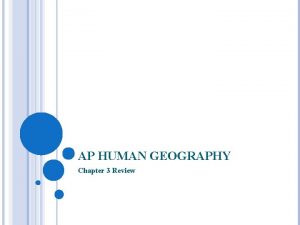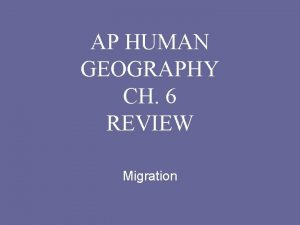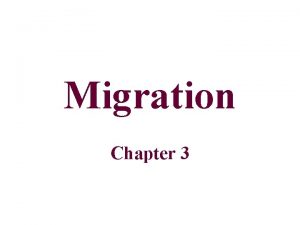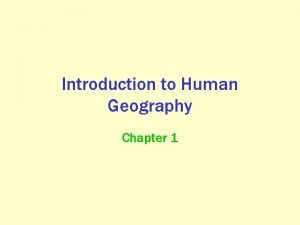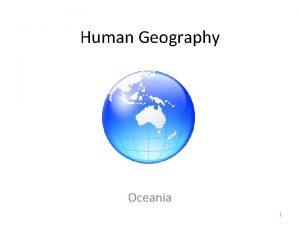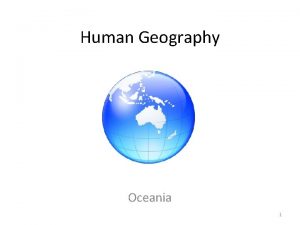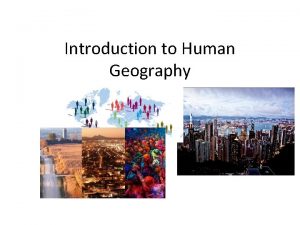Migration AP Human Geography Migration Migration a change






























- Slides: 30

Migration AP Human Geography

Migration • Migration: a change in residence that is intended to be permanent. • Emigration: leaving a country. • Immigration: entering a country. Little Haiti, Miami, Florida

Types of Migration • Forced Migration: migrants have no choice – they must leave. • Periodic Movement: short term (weeks or months) seasonal migration to college, winter in the South, etc. Commuter train in Soweto, South Africa

Types of Migration • Cyclic movement: daily movement to work, shopping. • Transhumance: seasonal pastoral farming. Switzerland, Horn of Africa. • Nomadism: cyclical, yet irregular migration that follows the growth of vegetation.

From 12 to 30 million Africans were forced from their homelands in the 18 th century. It took generations to restore the population balance.

Catalysts of Migration • Push-Pull Factors – Push factors induce people to leave – Pull factors encourage people to move to an area

Catalysts of Migration • Economic conditions – poverty and a desire for opportunity – has driven millions from their homelands – North America has received many legal and illegal immigrants from Mediterranean, Caribbean, across the Rio Grande • Political conditions – persecution, expulsion, or war – oppressive regimes- Mariel Boatlift from Cuba 125, 000, Boat People from Vietnam in 1970 s and 80 s • Armed Conflict-War – Rwanda-militant Hutus versus minority Tutsi and moderate Hutus-600, 000 died in out migration-2 million fled to Zaire

Economic Conditions – Migrants will often risk their lives in hopes of economic opportunities that will enable them to send money home (remittances) to their family members who remain behind.

Most illegal immigrants are Mexicans, but a growing number Are from Central and South America, like the men waiting Outside of “Bar Honduras” in Nuevo Laredo.

• A massive dump site in Arizona’s Upper Altar Valley. After walking 40 miles through the desert, illegal immigrants are met here by coyotes. They are told to dump their old clothes & packs and put on more “American” looking clothes the coyotes have brought. They then begin the trip to an urban stash house.

Catalysts of Migration • Environmental conditions – crop failures, floods, drought, environmentally induced famine. – Ex. potato famine 1840 s Ireland

Environmental Conditions –In Montserrat, a 1995 volcano made the southern half of the island, including the capital city of Plymouth, uninhabitable. People who remained migrated to the north or to the U. S.

Catalysts of Migration • Culture and tradition – threatened by change – Millions fled India for Pakistan, Soviet Jews fled to Israel • Technological advances – easier and cheaper to sail or fly – air-conditioning made south and southwest US more desirable.

Reconnecting Cultural Groups • About 700, 000 Jews migrated to then. Palestine between 1900 and 1948. • After 1948, when the land was divided into two states (Israel and Palestine), 600, 000 Palestinian Arabs fled or were pushed out of newly-designated Israeli territories.

Jerusalem, Israel: Jewish settlements on the West Bank.

Pull Factors • Same as push factors, but positively • Ex: United States – Plenty of economic opportunity – Politically free – Temperate climate – Melting pot of culture – Technologically advanced

Economic Opportunities Islands of Development – Places within a region or country where foreign investment, jobs, and infrastructure are concentrated.

Economic Opportunities In late 1800 s and early 1900 s, Chinese migrated throughout Southeast Asia to work in trade, commerce, and finance.

Voluntary Migration – Migrants weigh push and pull factors to decide first, to emigrate from the home country and second, where to go. Distance Decay weighs into the decision to migrate, leading many migrants to move less far than they originally contemplate.

Refugees A person who flees across an international boundary because of a well-founded fear of being persecuted for reasons of race, religion, nationality, membership of a particular social group, or political opinion.

Characteristics of Refugees • Move with only what they can carry or easily transport. • Most move first on foot, bicycle, wagon or open boat-very low tech. transport. • Most have no official documentation such as passports, identification or other official papers.

Ernst Ravenstein’s “Laws of migration” 1885 he studied the migration of England • • • Most migrants go only a short distance. Big cities attract long distance migrants. Most migration is step-by-step. Most migration is rural to urban Each migration flow produces a counterflow. Most migrants are adults-families are less likely to make international moves. • Most international migrants are young males.

Continued… • Today in the US young people in their 20 s are the most mobile. • Today 40 -60% of migrants are women and girls so the young males rule is less valid today than it was

Migrants face obstacles • Quota Laws-limit the number of immigrants from a particular country – Today: 480, 000 family-sponsored immigrants plus 140, 000 employment-related immigrants – Brain Drain: preference is given to educated immigrants thus causing a lack in their home countries

Guest Workers or Time-Contract Workers • Guest workers – migrants whom a country allows in to fill a labor need, assuming the workers will go “home” once the labor need subsides. - have short term work visas - send remittances to home country

Examples • Only recently has Germany allowed the Turks-now 2 nd or 3 rd generation-to become German citizens • Nigeria kicked out its guest workers • Indonesia pulled out its many citizens in the Middle East before the 2003 Iraq War

Cultural Problems • U. S. attitudes toward immigrants

Post-September 11

Tuaregs

Article Questions • Describe the Tuareg culture. • Why do the Tuareg continuously migrate? • Why has the country of Mali pushed the Tuareg out? • How has climate affected migration? • What political migration issues do the Tuareg now face?
 Internal migration ap human geography definition
Internal migration ap human geography definition Refugees definition ap human geography
Refugees definition ap human geography Circular migration ap human geography definition
Circular migration ap human geography definition What is ravenstein's law of migration
What is ravenstein's law of migration Stepek ap human geo
Stepek ap human geo Ravenstein's laws of migration ap human geography
Ravenstein's laws of migration ap human geography Ap human geography political geography frq
Ap human geography political geography frq 5 themes of geography ap human geography
5 themes of geography ap human geography Proruption ap human geography
Proruption ap human geography Human development index definition ap human geography
Human development index definition ap human geography Migratory paths of early humans
Migratory paths of early humans Leapfrogging ap human geography
Leapfrogging ap human geography Ap human geography chapter 11 vocab
Ap human geography chapter 11 vocab Topographic map definition ap human geography
Topographic map definition ap human geography Alpha beta gamma cities ap human geography
Alpha beta gamma cities ap human geography Heartland theory ap human geography
Heartland theory ap human geography Bulk-gaining industry ap human geography
Bulk-gaining industry ap human geography Johann heinrich von thünen model
Johann heinrich von thünen model Thnen
Thnen Bid rent theory ap human geography
Bid rent theory ap human geography Township and range ap human geography
Township and range ap human geography Suburban sprawl definition ap human geography
Suburban sprawl definition ap human geography Griffin ford model ap human geography
Griffin ford model ap human geography Central place theory definition geography
Central place theory definition geography Mdcs dubai
Mdcs dubai Modernization model ap human geography
Modernization model ap human geography Multiethnic state definition
Multiethnic state definition The geographic grid
The geographic grid Bid rent theory
Bid rent theory Median-line principle definition ap human geography
Median-line principle definition ap human geography Distortion
Distortion
